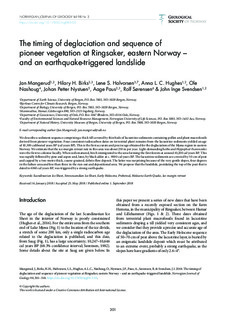| dc.contributor.author | Mangerud, Jan | |
| dc.contributor.author | Birks, Hilary H | |
| dc.contributor.author | Halvorsen, Lene Synnøve | |
| dc.contributor.author | Hughes, Anna L.C. | |
| dc.contributor.author | Nashoug, Ole | |
| dc.contributor.author | Nystuen, Johan Petter | |
| dc.contributor.author | Paus, Aage | |
| dc.contributor.author | Sørensen, Rolf | |
| dc.contributor.author | Svendsen, John-Inge | |
| dc.date.accessioned | 2019-07-02T07:44:45Z | |
| dc.date.available | 2019-07-02T07:44:45Z | |
| dc.date.created | 2018-09-25T12:48:44Z | |
| dc.date.issued | 2018 | |
| dc.identifier.citation | Norsk Geologisk Tidsskrift. 2018, 98 (3), 301-318. | nb_NO |
| dc.identifier.issn | 0029-196X | |
| dc.identifier.uri | http://hdl.handle.net/11250/2603114 | |
| dc.description.abstract | We describe a sediment sequence comprising a thick till covered by thin beds of lacustrine sediments containing pollen and plant macrofossils derived from pioneer vegetation. Four consistent radiocarbon dates on terrestrial plant remains from the lacustrine sediments yielded an age of 10,500 calibrated years BP (cal years BP). This is the first accurate and precise age obtained for the deglaciation of the Mjøsa region in eastern Norway. We estimate that the ice-margin retreat rate in this area was about 250 m per year. Light-demanding herbs and Hippophaë rhamnoides were the first to colonise locally. When soils matured, birch immigrated to the area forming the first forests at around 10,200 cal years BP. This was rapidly followed by pine and aspen and, later, by black alder at c. 9000 cal years BP. The lacustrine sediments are covered by 50 cm of peat and capped by a two-metre thick, coarse-grained, debris-flow deposit. The latter was surprising because of the very gentle slopes, four degrees in the failure area and less than three in the run-out and depositional area. We propose that the landslide, postdating the top of the peat that is dated to 6360 cal years BP, was triggered by a strong earthquake. | nb_NO |
| dc.language.iso | eng | nb_NO |
| dc.rights | Attribution-NonCommercial-NoDerivatives 4.0 Internasjonal | * |
| dc.rights.uri | http://creativecommons.org/licenses/by-nc-nd/4.0/deed.no | * |
| dc.title | The timing of deglaciation and the sequence of pioneer vegetation at Ringsaker, eastern Norway – and an earthquake-triggered landslide | nb_NO |
| dc.type | Journal article | nb_NO |
| dc.type | Peer reviewed | nb_NO |
| dc.description.version | publishedVersion | nb_NO |
| dc.source.pagenumber | 301-318 | nb_NO |
| dc.source.volume | 98 | nb_NO |
| dc.source.journal | Norsk Geologisk Tidsskrift | nb_NO |
| dc.source.issue | 3 | nb_NO |
| dc.identifier.doi | 10.17850/njg98-3-01 | |
| dc.identifier.cristin | 1613356 | |
| dc.relation.project | Norges forskningsråd: 229788 | nb_NO |
| dc.relation.project | Norges forskningsråd: 255415 | nb_NO |
| cristin.unitcode | 192,14,0,0 | |
| cristin.unitname | Miljøvitenskap og naturforvaltning | |
| cristin.ispublished | true | |
| cristin.fulltext | original | |
| cristin.qualitycode | 1 | |

